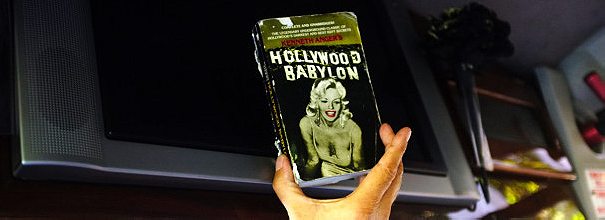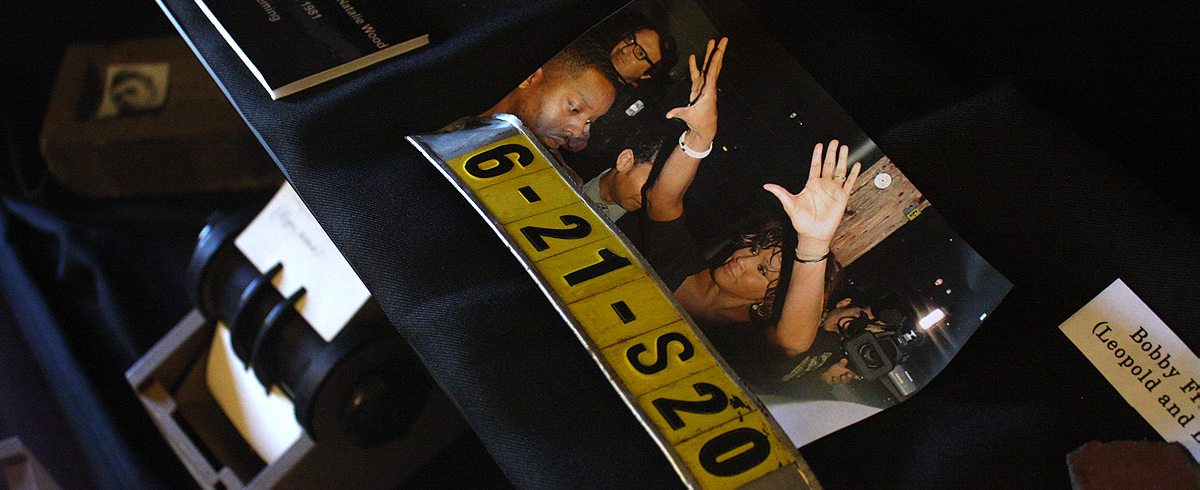This weekend, Death Hags from around the country will gather in the City of Angels to revel in the stories of L.A.’s famous deaths.
In the years following the death of Grigori Rasputin, his only surviving daughter spent a lifetime trying to rehabilitate him—showing that he was neither the “evil occult monster” nor the “saintly man of destiny” of legend, as she put it in one of her several memoirs. She also, in addition to fighting over her father’s memory, had a full life of her own: she left Russia, worked as a cabaret dancer in Romania, traveled the world as a circus trainer and became a riveter in the U.S. during WWII.
Maria Rasputin died in L.A., more than 5,000 miles away from the Siberian village of Pokrovskoye where she was born. By the end, her life of imperial Russian tiaras and U.S. factory overalls had become a humbler existence collecting social security benefits. Buried just south of downtown at Angelus Rosedale Cemetery, the first in the city that accepted burials regardless of race or creed, her humble, flat grave marker carries the year of her birth and death (1977) flanked by two boldly etched flowers.
Forget the Hollywood sign or the Sunset Strip: for a certain kind of tourist, an obscure tombstone with a delicious backstory is the real attraction of LA. And those kinds of tourists, who proudly call themselves Death Hags, are descending on the City of Angels this weekend for the Annual Dearly Departed Weekend. It promises to be three days of morbidity and camaraderie, with a cocktail party at the LA Coroner’s Office, “dinner among the dead” in the Pasadena Mausoleum, laughs at the Los Angeles Police Museum. Proceeds from the sold-out weekend will go toward a cause near to the group’s heart: buying a gravestone for character actor Jonathan Hale, who, as the website points out, committed suicide at the Motion Picture Country Home on February 28, 1966.

Though the men and women who populate this subculture come from all walks of life and live their civilian lives throughout the country, Los Angeles makes a particularly compelling rendezvous point for tomb tourism. The Hollywood Forever Cemetery literally shares space with a movie studio and offers stargazing tomb tours. It’s a place where murder victims become celebrities (Black Dahlia) and celebrities murder each other (Simpson et al.). The LA County Coroner has its own gift shop.
A dark interest in the afterlife and how various people got there is nothing new, but the Internet has turned what tended to be personal fascinations into a bona fide community. Findagrave.com was an early entrant, a site with millions of cemetery records and photos submitted by grave hunters across the world. Then came Hollywood Underground, the premiere group for L.A.’s grave-hunting community. Members would meet to exchange tips, have annual dinners and share their stories about getting thrown out by over-protective cemetery staff.
Scott Michaels, who is credited with coining the term Death Hag, says that these sites helped him feel less alone in his pursuits. “I think we all thought we were the only ones until the Internet. Finding like-minded people was a real surprise and joy,” he said.
If the afterlife had an ambassador, Michaels would be it. He attributes his longstanding fascination with death both to his Polish Catholic background, which he says exposed him to the pageantry of mourning, and to having grown up on a Detroit intersection where he says “fatal accidents were normal”. To feed his fascination, Michaels created findadeath.com, which tells the stories of people’s death, mainly celebrities great and small. The site is pure candy for his followers, a guilty pleasure that he has managed to turn into a full-time job.
Since 2005, he has operated Dearly Departed Tours, a sleaze and shock tour of death across L.A., from the comfort of a 14-seater van. Stops include the house where the Menendez Brothers killed their parents (as you listen in on their now-infamous 911 call), seeing the site where the Black Dahlia’s dismembered body was found and passing the phone booth where a then 19-year-old Joaquin Phoenix called for help to save his brother River after a fatal drug overdose outside The Viper Room club.

With Jayne Mansfield’s hot pink suitcase in the storefront window on Santa Monica Blvd, Michaels’ shop isn’t just a meeting place for ticket holders, but a make-shift museum. A curler from Phyllis Diller’s wig sits near wood paneling from Barker Ranch, the Manson Family’s final home in Death Valley. A boulder from the St. Francis Dam that broke in 1928, killing more than 600 people, is nuzzled near crime scene tape from the home of James Holmes, responsible for the recent Aurora, Colo. Theater shooting. Nearby, the actual door from Room 261 of the Regency Hotel is leaned up against a wall, where Harris Glen Milstead, better known as “Divine,” died in 1988.
“I tend to gravitate towards the items that people would have used in their every day life and some unusual article having to do with them,” says Michaels. It is his gift, really, the ability to take these celebrities off their pedestals and instead place them on the patios, sidewalks and hotel rooms where they took their last breaths.
“Death is the great equalizer,” Jayne Osborne, a proud Death Hag, tells me. “At the end of the game, all of the chess pieces go off in the same box.”

Though she’s not a professional guide, Osborne can lead you through the graves at many of the city’s cemeteries the same way other people can tell you directions to the 405. She met me recently on a Sunday afternoon at Hollywood Forever cemetery after spending her morning looking at another cemetery for the grave of Johnny Hyde, the Russian-American talent agent responsible for discovering Marilyn Monroe. She showed me the grave of Harry Cohn, the former president of Columbia Pictures who was “the most hated man in Hollywood.” Then she pointed out where Marion Davies, William Randolph Hearst’s mistress, is buried. Then came the final resting place of Alan Crosland, director of “The Jazz Singer,” who remained unmarked for 67 years until members of The Hollywood Underground raised the funds to buy him a marker.
Osborne often takes flowers to the graves of Farrah Fawcett and Jean Harlow among others—a way to honor the icons that impacted her life while growing up, and to pay homage to the history of a city that is often accused of having none.
And, of course, there is the black humor of it: “You get a map to the movie stars’ homes and you’re never sure that they live there,” she tells me graveside. “but when you go to a cemetery, it’s almost certain that they’re home.” It’s a joke she uses often, taught to her by Roger Sinclair, an octogenarian who started his hobby in the 50’s and considered by many to the “Godfather of Grave Hunting” in L.A.

Growing up, Obsorne wanted nothing to do with grave hunting. Her mother, a voracious reader of celebrity biographies, who would take her, often reluctantly, to see where her favorite stars had lived and died.
“I was horrified that my mother wanted to do that and I crouched down [in the car] so that no one could see me and she kept going ‘c’mon this is fun!,’” she says.
Over the years, her grave hunting trips with her mother turned into some of her fondest memories. “I look forward to your visits,” Osborne’s mother would tell her. The phrase was so endearing that Osborne had it etched on her mother’s tombstone when she passed away in 2007. Her mother’s large collection of biographies and other celebrity memorabilia were donated, at her request, to the gallery in Michaels’ shop.
Though she’s quick to spot a closet grave hunter, Osborne kept her interest in cemeteries a secret for decades, a caution that is common among Death Hags, who fear the judgment that comes along with having a fascination with the underworld.
“I didn’t tell people that I went to cemeteries… I didn’t want people to think I was creepy or weird,” she says, adding that she once had a co-worker who would introduce her and then quickly mention she liked to hang out in cemeteries. “They couldn’t understand what you were doing and they would avoid you.”
Osborne has even found love in the Death Hag community
The pressure would seem to be less these days, given the mainstreaming of goth, vampire and other cultures in pop media, from Twilight to True Blood on down. So not only is Osborne out of the closet as a Death Hag, she has even found love in the community. Her boyfriend Mark Masek is the author of “Hollywood Remains to Be Seen,” a guidebook to 14 cemeteries in the L.A. area and the final burial locations of more than 300 celebrities.
Among the gems in Masek’s book: the tale of Marion Parker, the daughter of a prominent L.A banker who was kidnapped, murdered and gruesomely butchered by William Edward Hickman, a criminal who called himself “The Fox”, in 1927. Parker was returned to her father after a ransom was handed over—but it was too late. She—and brace yourself for these details, which are somewhat typical of Masek’s work—had been disemboweled and stuffed with rags—her eyelids sewn open to make it seem like she was still alive. The building where she was murdered was remodeled and turned into swanky rental apartments last year.
The story of flying trapeze artists Alfredo Codona and Lillian Leitzel, arguably the best in their trade at the start of the 20th century, is one of Masek’s best finds. He stumbled upon it thanks to an almost 20-foot high grave marker that commemorated their love affair at Inglewood Cemetery Park. “In Everlasting Memory of my Beloved,” reads the inscription, just below a broken trapeze ring.
With her husband away in Berlin, Leitzel fell 50 feet in the middle of an act while performing in Copenhagen. She survived the fall, and when Codona rushed to her from Germany she assured him she was fine, urging him to return to Berlin. But she took a turn for the worse and died a few days later. Devastated, Codona commissioned the marble statue from an Italian sculptor to be erected at her grave.
He remarried, began to drink heavily and sustained injuries that forced him from the ring into working at an auto garage in Long Beach. While finalizing the details of his divorce from his second wife, he shot her and then turned the gun on himself in the lawyer’s office. In his suicide note, he asked to be buried next to Leitzel.
‘Every cemetery is like a library,’ Masek says.
It’s a story Masek found, researched and archived on his site, cemeteryguide.com, along with other tales long forgotten and replaced over decades with the headline makers of today. Of course, though Leitzel’s death, at the height of their fame, was reported, Codona’s murder-suicide wasn’t. The world had moved on.
“Every cemetery is like a library,” Masek says, “and every person has a story. Some of them are interesting and well known, and some of them aren’t, but they’re all worthy of being remembered.”
Masek is one of the speakers at the dinner inside the Pasadena Mausoleum this weekend. Masek will share details of the Lamb Funeral Home scandal, where bodies were mutilated, butchered and sold instead of buried by a greedy Southern California mortician in the late 80s. The tale promises, say the event organizers, to be “insane, gross, disturbing and fascinating”.